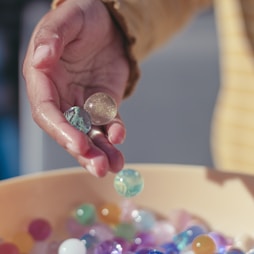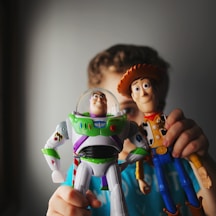Active Learning at Home : Empowering Moms to Connect with Their Highly Sensitive Children
Unlocking the potential of highly sensitive children through these five fun home-based activities that nurture empathy, creativity, and intuition. Discover how to nurture these valuable skills using materials you may already have at home.


Photo by Katie Emslie from Unsplash
Note: As an Amazon Associate I earn from qualifying purchases. This post contains affiliate links, meaning that if you choose to click through and make a purchase, I will receive a small commission at no extra cost to you.
Hey there!
Parenting can be a rollercoaster ride of emotions and adventures, especially when you have highly sensitive children.
These little beings possess an extra dose of empathy, creativity, and intuition, making them truly special.
We'll explore creative ways to engage in active learning activities right at home using items you probably already have😊.
Table of Content
Showtime for Emotional Intelligence
1. Cozy Corner
Establishing a cozy corner marks the first step in forging a deep and meaningful connection with your highly sensitive child.
These items will help create a comfortable and inviting corner.
Feel free to click on any item below to see an example:
Stuffed animals
Reading light
Plants
ACTIVIDADES
1. Sensory Exploration: Utilize the cozy corner for sensory activities that engage the child's senses, such as textured fabrics, calming music, or scented items.
2. Storytelling: Share stories together, whether it's reading books or creating imaginative tales.
3. Mindfulness Practices: Practice mindfulness and relaxation techniques together, such as deep breathing exercises or guided imagery.
4. Emotional Check-ins: Use the cozy corner as a place for regular emotional check-ins, where you and your child can discuss feelings in a calm and non-judgmental manner.
5. Nature Connection: Bring elements of nature, such as plants, natural materials, or pictures of outdoor scenes.
6. Journaling: Encourage journaling as a way for the child to reflect on their thoughts and emotions.
7. Playful Learning: Integrate playful learning activities, such as puzzles, board games, or educational toys.




2. Sensory Adventures
Highly sensitive children often find comfort in sensory activities.
Fill a large plastic container with rice or beans, hide some small toys in it, and let your child embark on a treasure hunt.
This activity keep them engaged for hours!


Water beads are also a great sensory material!
Storing them is simple too; pop them into clear bottles or ziplock bags.
When playtime's over, you can crumble them into potted plants in your garden. Just remember, never toss them down the drain or into a garbage disposal – they can cause plumbing havoc!
3. Cereal Box Puzzle
Now, let's talk about educational activities that'll make learning a breeze.
Remember those empty cereal boxes you were about to recycle?
They make fantastic DIY puzzles!
Cut them into pieces, and let your child's imagination run wild as they piece together their masterpiece.


From Munchkins and Moms
5. Showtime for Emotional Intelligence
Materials Needed:
Dolls or action figures
Imagination
Activities:
Dolly Dialogue: Grab some dolls or action figures and gather your child for some pretend playtime. Let them choose a character and give them a name.
Emotion Exploration: Talk about emotions playfully.
Ask your child, "How would your doll feel if it found a treasure chest?" or "What if the doll lost its favorite toy?"
Expressive Play: Encourage your child to act out scenarios with their dolls that reflect emotions.
For example, they can have a doll throw a mini celebration or help another doll when it's feeling down.
Repeat and React: Keep the doll drama going whenever your child is in the mood. You'll find that they naturally explore emotions and empathy as they let their dolls take the stage.
Through these mini adventures, your child can learn valuable social and emotional skills while enjoying quality time with their favorite dolls or action figures.
Happy playtime!😌





We'd love to hear from you!
Share your thoughts in the comments below
Tracing, Rhyming, and Coloring Fun!
My First Math Book for Learning Numbers 0 - 10
Valentine's Day Coloring Book
Letter tracing practice ages 2-5)
Toddler Halloween Coloring & Number Tracing Book
Bold, Easy, Spooky Stuff + Learning Numbers Activities for Kids Ages 3+











4. Social Skills Activities
Create a 'conversation jar' filled with interesting topics written on pieces of paper.
At dinner, everyone takes a turn to pick a topic, and voila! Meaningful conversations are served with a side of spaghetti.
Here are some examples:
Favorite Books: What's a book you love, and why?
Dream Adventures: If you could go on any adventure, what would it be like?
Kind Acts: Can you share a time when someone was really kind to you, or when you were kind to someone else?
Animal Friends: What's your favorite animal, and what do you like most about it?
Favorite Memories: What's a special memory you have with our family?
Superpowers: If you could have any superpower, what would it be, and how would you use it?
Favorite Foods: What's your favorite food, and why does it make you happy?
Heroes and Role Models: Who is someone you look up to, and what do you admire about them?
Family Traditions: What's a tradition in our family that you really enjoy?
Future Dreams: What do you dream about for your future? Where do you see yourself?
These topics foster open communication and connection within the family.